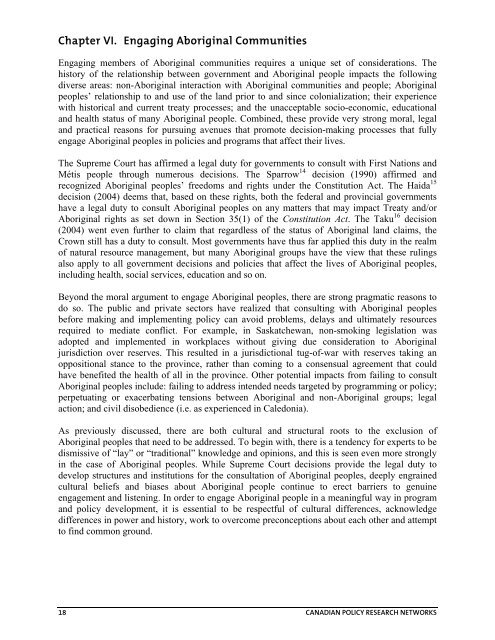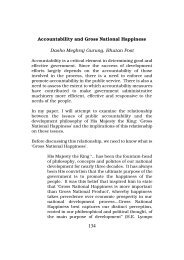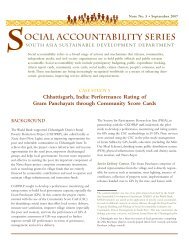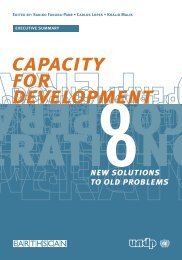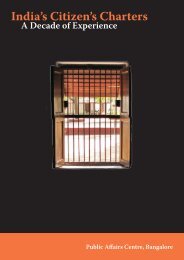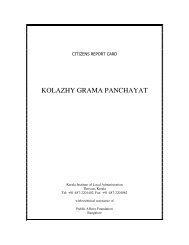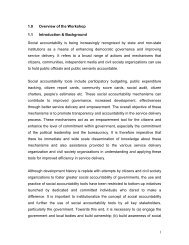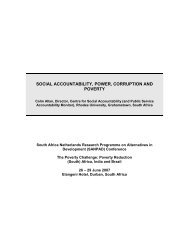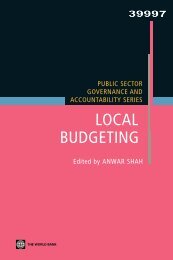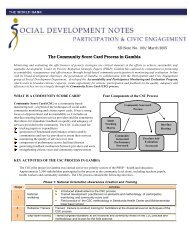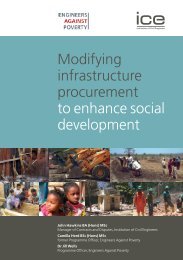Handbook on Citizen Engagement: Beyond Consultation - SASANet
Handbook on Citizen Engagement: Beyond Consultation - SASANet
Handbook on Citizen Engagement: Beyond Consultation - SASANet
- No tags were found...
Create successful ePaper yourself
Turn your PDF publications into a flip-book with our unique Google optimized e-Paper software.
Chapter VI. Engaging Aboriginal CommunitiesEngaging members of Aboriginal communities requires a unique set of c<strong>on</strong>siderati<strong>on</strong>s. Thehistory of the relati<strong>on</strong>ship between government and Aboriginal people impacts the followingdiverse areas: n<strong>on</strong>-Aboriginal interacti<strong>on</strong> with Aboriginal communities and people; Aboriginalpeoples’ relati<strong>on</strong>ship to and use of the land prior to and since col<strong>on</strong>ializati<strong>on</strong>; their experiencewith historical and current treaty processes; and the unacceptable socio-ec<strong>on</strong>omic, educati<strong>on</strong>aland health status of many Aboriginal people. Combined, these provide very str<strong>on</strong>g moral, legaland practical reas<strong>on</strong>s for pursuing avenues that promote decisi<strong>on</strong>-making processes that fullyengage Aboriginal peoples in policies and programs that affect their lives.The Supreme Court has affirmed a legal duty for governments to c<strong>on</strong>sult with First Nati<strong>on</strong>s andMétis people through numerous decisi<strong>on</strong>s. The Sparrow 14 decisi<strong>on</strong> (1990) affirmed andrecognized Aboriginal peoples’ freedoms and rights under the C<strong>on</strong>stituti<strong>on</strong> Act. The Haida 15decisi<strong>on</strong> (2004) deems that, based <strong>on</strong> these rights, both the federal and provincial governmentshave a legal duty to c<strong>on</strong>sult Aboriginal peoples <strong>on</strong> any matters that may impact Treaty and/orAboriginal rights as set down in Secti<strong>on</strong> 35(1) of the C<strong>on</strong>stituti<strong>on</strong> Act. The Taku 16 decisi<strong>on</strong>(2004) went even further to claim that regardless of the status of Aboriginal land claims, theCrown still has a duty to c<strong>on</strong>sult. Most governments have thus far applied this duty in the realmof natural resource management, but many Aboriginal groups have the view that these rulingsalso apply to all government decisi<strong>on</strong>s and policies that affect the lives of Aboriginal peoples,including health, social services, educati<strong>on</strong> and so <strong>on</strong>.Bey<strong>on</strong>d the moral argument to engage Aboriginal peoples, there are str<strong>on</strong>g pragmatic reas<strong>on</strong>s todo so. The public and private sectors have realized that c<strong>on</strong>sulting with Aboriginal peoplesbefore making and implementing policy can avoid problems, delays and ultimately resourcesrequired to mediate c<strong>on</strong>flict. For example, in Saskatchewan, n<strong>on</strong>-smoking legislati<strong>on</strong> wasadopted and implemented in workplaces without giving due c<strong>on</strong>siderati<strong>on</strong> to Aboriginaljurisdicti<strong>on</strong> over reserves. This resulted in a jurisdicti<strong>on</strong>al tug-of-war with reserves taking anoppositi<strong>on</strong>al stance to the province, rather than coming to a c<strong>on</strong>sensual agreement that couldhave benefited the health of all in the province. Other potential impacts from failing to c<strong>on</strong>sultAboriginal peoples include: failing to address intended needs targeted by programming or policy;perpetuating or exacerbating tensi<strong>on</strong>s between Aboriginal and n<strong>on</strong>-Aboriginal groups; legalacti<strong>on</strong>; and civil disobedience (i.e. as experienced in Caled<strong>on</strong>ia).As previously discussed, there are both cultural and structural roots to the exclusi<strong>on</strong> ofAboriginal peoples that need to be addressed. To begin with, there is a tendency for experts to bedismissive of “lay” or “traditi<strong>on</strong>al” knowledge and opini<strong>on</strong>s, and this is seen even more str<strong>on</strong>glyin the case of Aboriginal peoples. While Supreme Court decisi<strong>on</strong>s provide the legal duty todevelop structures and instituti<strong>on</strong>s for the c<strong>on</strong>sultati<strong>on</strong> of Aboriginal peoples, deeply engrainedcultural beliefs and biases about Aboriginal people c<strong>on</strong>tinue to erect barriers to genuineengagement and listening. In order to engage Aboriginal people in a meaningful way in programand policy development, it is essential to be respectful of cultural differences, acknowledgedifferences in power and history, work to overcome prec<strong>on</strong>cepti<strong>on</strong>s about each other and attemptto find comm<strong>on</strong> ground.18 CANADIAN POLICY RESEARCH NETWORKS


